Alocasia family has so many exotic plants, but Alocasia Black Velvet stands out among all because of its stylish appearance ,texture and compact growth habits. It exhibits contrasting silver veins which are prominent over dark leaves with a velvety background. This elegant plant, also known as Little Queen, needs a special care regime. The spectacular little queen is a member of Jewel Alocasia ( dwarf Alocasia) and is native to Southeast Asia.
What makes this diminutive gem different from others is its dark, thick, succulent-like leaves gilded with silver or white well defined veins. This beauty features an appealing heart-shaped foliage and has a velvety touch, literally the most luscious thing ever. The leaves are quite velvety ,very fleshy and stiff textured and can grow up to six inches long and two-and-a-half inches wide. As far as the height is concerned, it’s a compact plant that can grow up to eighteen inches only, unlike its other family members such as Alocasia Stingray or Alocasia Sarian.
Are Alocasia Black Velvet hard to care for?
The little Queen is a moderate to care for compared to other Jewel Alocasias; however, it is peculiar about its watering and light requirements. Provide this beauty the ambience it craves, and it will grow to its full potential and adorn your place. Black Velvet is most probably the smallest of all the Jewel Alocasias, making it a perfect candidate for terrariums and Ikea Cabinets to make a big impression in small spaces.
Some people might feel that these grow really slow because they do tend to lose their bottom leaves when the new leaves come in, and it might not feel like it is not making a lot of progress. However, you would find many plant parents raving about their Black Velvet Alocasia being an easy and most rewarding among other Jewel Alocasias.
Alocasia Reginula is a little picky and slow growing plant and may go dormant or lose a leaf without proper attention. Moreover, when they get fussy they can be a part of the one leaf club or they can have the one in one out policy -that is fairly common with these plants. Definitely not a plant for beginners or people with brown thumbs! However with proper care it reward you with beautiful , juicy, velvety foliage. Totally worth the effort !!
Allied Species: Alocasia Sarian, Alocasia Pink Dragon, Alocasia Lauterbachiana, Alocasia Silver Dragon, Alocasia Stingray, Alocasia Regal Shields, Alocasia Nebula, Alocasia Maharani, Alocasia Jacklyn , Alocasia Cuprea,
Related Products
Products | Name | Check Price |
Organic Perlite for Plants | ||
WONDER SOIL Organic | ||
Orchid Potting Bark Mulch |
Habitat & Ecology
| Botanical Name: | Alocasia Reginula |
| Family Name: | Araceae |
| Common names: | Alocasia Black Velvet, Little Queen , Jewel Alocasia |
| Plant Type | Herbaceous, Perennial |
| Origin | Southeast Asia |
| Height | 15- 18 inches |
| Flower | Insignificant Inflorescence ( white) |
| Humidity | Above 60% |
| Light Need | Medium to bright indirect light |
| Soil Type | Well-drained moist soil |
| Bloom time | Spring / Summer |
How to Care for Black Velvet Alocasia?
When it comes to the care of Alocasia Black Velvet, it needs careful watering and well-draining soil to thrive. Alocasia Reginula loves warm and humid environments, along with indirect sunlight. In this article we are sharing a detailed guide about the care of Alocasia Black velvet; keep reading to know how to take best care of this sought after beauty.
We are going to share some tips and tricks to make sure it is as happy as it can be and help you grow a big, beautiful plant.

Initial Care at Home
The little queen is a perfect plant for small spaces such as tabletops, Ikea Cabinet shelves, or study table. It’s a slow grower as they tend to lose its bottom leave when new leaves come in. However, the worthy thing is that it’s marginally hardier than other Alocasias in the family as it can endure a bit harsh condition (for some people).
When bringing home this beauty, quarantine it before introducing it to other plants in your collection. Carefully inspect the foliage and look for any pests and disease symptoms. If infected , treat the plant before placing it with other plants to prevent the spread.

Watering of Alocasia Reginula
Watering can be one of the most challenging things when it comes to Black velvets, Alocasias, in general. It is where they tend to be their pickiest. Once you’ve figured it out, they’ll thrive and produce gorgeous velvety leaves. You need to refabricate a natural atmosphere for black velvet which means water it slightly but regularly.
They do like to stay quite moist, but they have very fragile fine roots that need room to breathe between waterings; otherwise, your plant will probably get root rot. If you got your plant in soil, I would suggest watering it when the soil is dry, about halfway down, maybe three-quarters of the way. That would be ideal for this plant because you’re letting the roots breathe between the waterings.
Although this genus requires a decent amount of water in the growing season, probably once a week watering. Please ensure you water it deeply, thoroughly saturate the soil, and let it sit for half an hour to drain the excess water from the soil. The little queen doesn’t need frequent spraying, and the frequency becomes less during winter because they might go into dormancy.
How to Determine?
Over-watering is much more about the frequency of watering the plant than the amount you water. So, you don’t want to be watering too often, so waiting until the soil is dry is super important. We recommend using your finger or a moisture meter or sensor like that to really make sure that the top of the soil is dry before you give it anything else. Stick to a soil moisture based schedule rather than a time based one to prevent overwatering.
If you keep your Alocasia Black Velvet in PON, the watering schedule looks slightly different because it is like a somewhat self-watering system. You don’t need to worry as much about over-watering because, in PON, you can kind of let the plant take up what it wants rather than force it upon it. Since it has a water reservoir, you don’t need to water nearly as much.
We suggest using distilled or purified water because they can be sensitive to the minerals in tap water, well it really depends on your area.
A wrong watering schedule may cause a leaf loss within hours or plant’s death. One of the most common reasons for plant death is root rot caused by overwatering. That’s why it’s essential to be careful with the spraying schedule of Alocasia black velvet.

Light Need of Alocasia Black Velvet
Like all other tropical plants, Alocasia Black Velvet also prefers indirect bright light, but they can tolerate a little bit lower into the medium as well because of these fantastic dark black leaves.
A fun fact about this plant is that it has really dark leaves because, in its natural habitat, it usually lives on the floor of the jungle, basically fully covered by the shade of the forest’s canopy. So, they evolved this dark black foliage to collect as much light as possible to give themselves the energy to grow.
Therefore, it’s imperative that you choose the right place for this plant preferably an east or northeast facing window with filtered light. The most favored spot is a bright room of your home, just a little bit pulled back from a window, where it gets bright indirect sunlight. However, too much direct light can scorch the leaves, an irreversible damage. They’re not like the thinnest of leaves, but they are still susceptible to sunburn, so avoid the bright direct hot sun for long periods. If you have chosen an outdoor spot for this striking beauty, ensure to place it under a shade.
Alocasia Reginula also stays happy under grow lights. My black Velvet lives in my Ikea cabinet, so it gets the grow light a decent amount during the day. During spring and Summer, it needs less time of grow lights, about three hours a day, and the bright indirect light from outside is ambient for the rest of the day. During winter, the plant may need the grow lights for about seven hours daily. They really need that extra boost if you are in a place where it is dark in Winter and would definitely thank you by producing some fantastic, gorgeous, beautiful leaves.
Effect of Low Light
However, if you’re not giving them enough light, they can grow quite leggy or even go dormant, which means they’re not going to produce any new growth. Moreover, Black Velvet might also lose some of its older leaves which would be devastating as it already possesses numbered leaves. Therefore, appropriate daylight is obligatory for the healthy growth of the little queen.

Humidity and Temperature
Alocasia Black Velvet is a tropical lowland plant that prefers high humidity and warmth to thrive.
Temperature
It likes to stay quite warm, and its ideal temperatures are between 15 to 27 degrees Celsius or 60 to 80 degrees Fahrenheit. Any cooler than like 15 Celsius or 60 Fahrenheit and you could risk your plant going into dormancy and even dropping leaves which is not ideal. Therefore, if you can avoid lower temperatures that would be great.
Black Velvet Alocasia also don’t like hot and cold drafts and significant fluctuations in temperature so if you can keep them away from drafty windows, air vents, and heaters, it would keep them happy. Otherwise, they not going to like that situation and won’t grow as well as you want them.
Summers are perfect in terms of temperature as it gets enough warmth when kept outside. But when the temperature drops, proper heat arrangements should be made to make this beauty feel like home. The foliage is not frost tolerant so you need to bring them inside if you kept them outside in summer or make sure that the tubers are very deep enough where they don’t get hard frost.
Humidity
High humidity is vital for the good growth of Alocasia black velvet. Alocasia Reginula loves humidity so freaking much like they’re here for the humidity. Ideally, if you can give them at least 60% humidity that would be good, but they’ll prefer somewhere in the 70% range a bit better. It’ll help them grow better so if you can provide that for them. However, these plants can tolerate low humidity like 30% to 40% in my humble opinion, just saying from my experience.
If your humidity is too low, it can cause your leaves to crisp up and go brown along the edges – that’s a pretty common problem with these ones. Hence, keep an eye out for that if that’s happening, you might want to put it in a more humid place like putting your plant in a kitchen or a bathroom.
Moreover, grouping it with other plants naturally boosts humidity, or putting on something like a pebble tray filled with water can help with the increase in humidity. If none of that helps you can get a humidifier to help boost the humidity that’s probably the easiest way to get humidity higher. Plus, putting your plant in Ikea Cabinet can provide loads of humidity to this dark green gem. You can also find a spot in a steamy bathroom or a kitchen.
Alocasia Black Velvet also loves being in PON because it creates extra humidity, the water reservoir at the bottom of the PON allows water to just slowly evaporate as well giving a kind of a bubble of humidity around the plant which it adores. It’s just another benefit of why Alocasias should go in PON.
Winters could be challenging for Alocasia black velvet, especially in terms of humidity, as the heating system dried the air indoors and can put the plant in danger. Therefore, it’s significant to provide a humid spot in winter.

Soil Requirements:
The soil conditions should support the particular needs of this exquisite plant. It requires soil that retains moisture without getting waterlogged. If you’re going to put your plant in a soil medium a coarse well-draining mix is super important ideally something peat free is good because you don’t need to hold on to too much water because that can suffocate the really fine roots that are like yearning for some air. Plus, putting your plant in a pot with drainage holes is super important because you don’t want just water sitting at the roots.
We recommend preparing an organic airy soil mix for this plant. It should be well aerated, well-draining, and moist.
We suggest making a potting mix that contains the following ingredients
Add all the components in a box and thoroughly mix them. Your perfect chunky potting soil is ready for Alocasia Black Velvet.
As mentioned earlier these plants are the perfect candidate for PON because it allows that perfect balance of moisture and air especially in a self-watering system. Moreover, Black Velvet also enjoys LECA growing medium.

Repotting:
Alocasia Black Velvets actually like to be very snug in their pots, and the roots want to be quite tight; therefore, we recommend to tease the roots little bit when repotting. Additionally, this plant has a limited root system, and a big container will have extra soil around the roots that can retain more water than required. This scenario can be dangerous and may result in many diseases, such as root rot.
Here are some tips that you should consider while repotting the plant

Propagation of Alocasia Black Velvet
Propagation is the process of creating new plants. You can propagate the little queen by using the following methods explained below.
Propagation through Corms
The easiest and most common way to propagate Alocasia Black Velvet and all Alocasias is through little corms or bulbs that you will find usually underneath the substrate growing by the roots of your Alocasia plant .The first thing you want to do is make sure that your corm is firm you do not want it to be squishy because then when you try and like moisten it to help it grow it will rot and won’t grow anything.
Therefore a nice and firm corm is required for propagation. You can use a method called the shallow puddle method where you get a small little container and fill it just a tiny bit with water just so it covers the bulb about halfway and close the container. Just let it sit it doesn’t necessarily need to be anywhere bright.
Once the bulb starts growing roots and what looks like a sprout then you can pot it up into your preferred growing medium such as PON, LECA, or aroid potting mix.
Propagation through Offsets:
It is the easiest method of propagation. The process is easy and involves separating the offsets from the main stem and planting them in a shallow pot.Use a sterilized knife or shears to cut the baby plant from the mother plant ( main rhizome). Please do not alter the soil mix and use the same soil in which the parent plant is growing. Retain the soil moist until the plant gets established.
Propagation through Division:
Alocasia Reginula is a rhizomatic plant and you can divide the rhizomes and plant them in separate pots. Please ensure each section has a growth node. Use the same soil as the parent plant and keep them in a humid place with ample indirect sunlight. Remember to maintain the soil moist until you notice new growth, after which you can recommence regular watering.
Propagation through Seeds:
You can propagate the Alocasia black velvet through seeds also, but it is very unpopular and not very successful method. Although it’s a slow and unreliable process, but it’s possible. The flowers shall be pollinated first if you want to use homegrown seeds. Once you have the berry after pollination, remove the seeds from the berry and soak them overnight in distilled water. Plant the seeds the next day immediately in a specially prepared soil mix.

Fertilizer
The little queen is a slow grower, and heavy feeding will not aid much for rapid growth. However, a light fertilizer will be beneficial for foliage size and colour.
During the growing season, you need to fertilize them probably about once a month in the Spring and Summer but not at all in autumn and winter. If you do have your plant in PON lechuza, it already has Slow release fertilizer in it which will last probably about six months, and then after that, you need to supplement fertilizer.
You can use liquid Gold leaf fertilizer for hydroponics or semi-hydro or even if your plant is in the soil. You can also use all-purpose fertilizer to feed this plant. Make sure to try half strength before going all in with it because some of those all-purpose fertilizers can really burn the roots of the plant which is not ideal.
If your plant is in the soil, a monthly or every two weeks feeding is sufficient, and a balanced liquid houseplant fertilizer is impeccable for this plant and will do the job.

Maintenance:
Although it’s a relatively high-maintenance plant regarding watering and soil requirements, pruning isn’t required that frequently. To maintain its healthy growth and provide nutrients to new leaves, trim away the old and dead leaves and foliage regularly.
The Velvety leaves might attract dust , therefore regularly wipe the leaves to prevent the pore’s blocking and photosynthesize better.
The flowers of black velvet aren’t that attractive, and they also bloom very rarely, so when it flowers, it’s recommended to snip them to entertain energy to the foliage.

Toxicity
Unfortunately, Alocasia Black Velvet plants are toxic to animals and humans so keep them out of reach of your pets and children .Alocasia black velvet contains needle-shaped crystals of calcium oxalate, which are harmful to humans and pets. These crystals irritate the mouth and digestive system.
You do not want them munching on this. Ingestion can cause stomach irritation and so much more so just avoid it at all costs. It is recommended to wear gloves while repotting and propagating this one because the sap can be an irritant. Use gloves during pruning and repotting to avoid any irritation and allergies.

Common Problems and Pests
While Alocasia Black Velvet needs apt care and requires a humid, warm environment, abundant sunlight, and a good watering schedule to survive, however, taking care of all these requirements, it’s essential to keep an eye on the following problems.
Curling leaves: This issue arises when the plant is kept in direct sun. If you notice leaves crumpling at the edges, move the plant to a shade where there is dapple light.
Yellowing leaves: Yellowing leaves are caused because of overwatering. When you spot the yellow leaves, try adjusting the waiting schedule and consider well-draining soil.
Loosing leaves: Usually, this plant has a pretty consistent number of leaves. Sometimes it’ll have two new ones come in before an old one dies off so if you’re experiencing that with yours don’t feel like it’s only you, it’s completely normal with these plants.
Brown tips: Overwatering is the biggest issue of Alocasias, but if they don’t get enough water, their leaves turn brown. Unnecessary application of fertilizer can also burn the leaves.
Guttation: Water dripping from the leaves is called “guttation” and may not necessarily be a problem if happens occasionally.
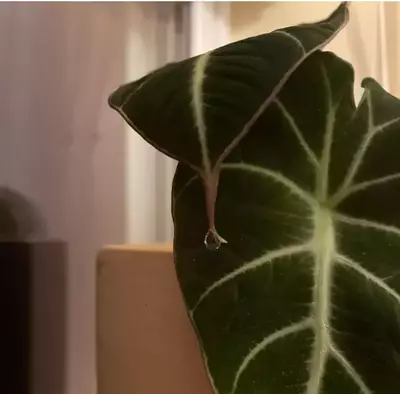
If it has been a while since you watered the plant, the soil medium may be holding too much moisture resulting in the plant being overwatered. Water less frequently or make the medium chunkier so it retains less moisture. It’s all about experimentation! A little guttation is totally normal
Pests
The black velvet isn’t immune from the attack of pests. A pest invasion may stress your plant; therefore, inspect the plant’s foliage and soil regularly to look for any pests.
Spider mites: The most common pests that attack the little queen are spider mites. They grow in dry and less humid conditions. If you notice mites on your plant, spray your plant with a diluted solution of water and soap. Make sure to get into the little cracks and crevices down the petioles, as the spider mites just get stuck in that stem area where it creeps into the plant. Repeat the process twice a week until the problem is entirely resolved.
Diseases
Although the plant is disease resistant, diseases can occur when there is excessive moisture. To avoid any illness, ensure enough air circulation and do not overwater the plant.
Leaf spot: Fungal leaf spot disease is caused by overwatering. When the moisture is allowed to rest on the foliage, it causes the staining of the leaves. When you notice any such leaves, remove them immediately and keep your plant in an airy place.
Leaf Mold or Red Spots:Velvety textured leaves of Alocasia Reginula are susceptible to mold or little red spots if they consistently have that water staying on them due to misting. If you are misting the velvety leaves of your Alocasia with little hand sprayers, be mindful of if and stop misting once you notice spots.
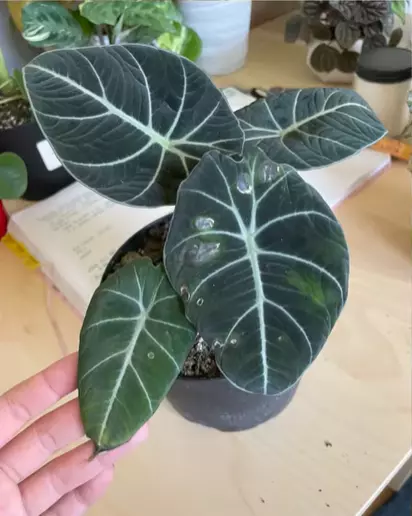
Root rot: If the plant is left in wet soil for a long time. It can cause root rot which is a dangerous disease. Mushy stems and yellowing droopy leaves are the signs of root rot. Regrettably, it’s not treatable, but you can prevent this disease by watering the plant reasonably when necessary.
Frequently Asked Questions:
How big does an Alocasia Black Velvet get?
Alocasia Reginula ‘Black Velvet Alocasia’, a member of Jewel Alocasia (dwarf Alocasias), is a low-ground plant exhibiting velvety dark green, almost black leaves and contrasting silver veins. Under ideal conditions, it grows up to 15- 18 inches tall, featuring large stunning textured leaves.
Are black velvet plants rare?
Alocasia Rginula ‘Black Velvet’ is one of the sought-after Jewel Alocasia in recent years. However, it is not a rare plant, as many of these Alocasias are currently in cultivation in Plant nurseries. These plants are in demand by many plant parents due to their compact size and soft, velvety, peltate leaves contrasting striking silver venation.
Should I mist Alocasia Black Velvet?
Alocasias like high humidity, and if there is a dry atmosphere, misting the plant is a good idea to provide the required humidity. The ideal humidity level for Alocasia black velvet is 60% to 75%.
What is the reason that my Alocasia Black Velvet is dying?
Overwatering is usually the most probable cause of Black velvet death. Overwatering can cause the devastating problem of root rot. If you spot any signs of root rot, remove the plant from the pot and see if it has mushy stems. Remove the affected stems and replant them in a new container using fresh pot soil.
How fast the Little Queen does grow?
Alocasia black velvet is a slow grower compared to its counterparts. It takes two to five years to reach maturity.
Where should I put my little Queen?
This plant likes bright locations with partial shade( if grown outside) where there isn’t direct sun. Please keep it in a place with enough indirect light and enough humidity.
How often should I water Alocasia black velvet?
You should water the plant when the top two inches of soil are dry. This plant loves moist soil and humidity, so ensure you don’t let the soil completely dry.
Final Words
If you want a small exotic, luscious jewel Alocasia that is relatively less fussy for your home, then Alocasia Black Velvet would be the right choice. Its deep green, thick leaves with silver veins will make your place vibrant. It’s perfect for small areas such as Ikea Cabinet , Shelves due to its compact size and striking beauty. Plus, it gives a stylish look to your place when planted in hanging baskets or planters.
Although it’s a little picky plant and will need your care and attention but, it’s worth it. However, you must be vigilant that it should be out of reach of children and pets as its toxic.
We hope you have liked this article, and it will help you grow this superb beauty in your home with care.
Happy Planting Jewel Alocasia!!!
Related Posts
Calathea Musaica | Network Calathea Care Guide
Calathea Musaica attracts plant lovers because of its adorable foliage with dark and light-colored patterns. Calathea Mosaic is a member of the Marantaceae family and is also famous as Network Calathea due to its characteristic mosaic pattern like a complex…
Calathea Fusion White Care Guide
Calathea plants are famous for their attractive evergreen foliage. If you are fond of collecting leafy tropical plants, then this gorgeous specie of Calathea Fusion White is a must for you. As the name indicates, it has a white colour…
Calathea Louisae Maui Queen Care Guide
Calathea Louisae is an adoring, colorful plant boasting beautiful leaves and a unique color pattern. It perfectly displays the beauty of the Calathea family, known for its exotic foliage with ornate, symmetrical shapes. The plant is one of the less…
Calathea Zebrina | Calathea Zebra Plant Care Guide
Calathea Zebrina is a species famous as the Calathea Zebra plant that belongs to the family Marantaceae. The Calathea Zebra plant is an evergreen ornamental plant with distinctive dark green velvety leaves having lime green alternative stripes giving it a pattern…
Rattlesnake Plant | Calathea Lancifolia Care Guide
Goeppertia Insignis, commonly known as Calathea Lancifolia or Rattlesnake plant, is a unique houseplant that originates from Brazil. It has distinctive deep green colored leaves shaped like spears. The plant gets the nickname of Rattlesnake plant due to the characteristic…

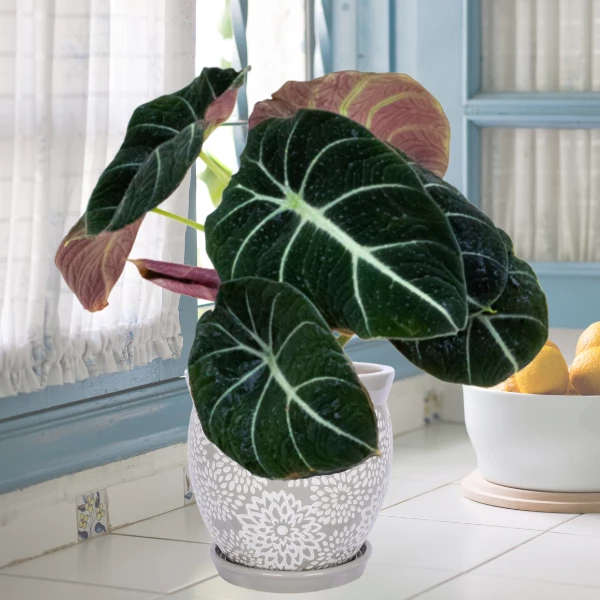





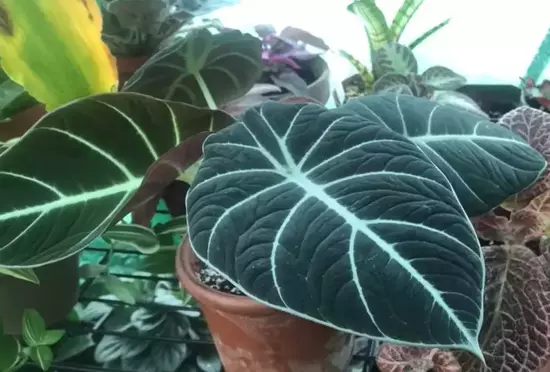


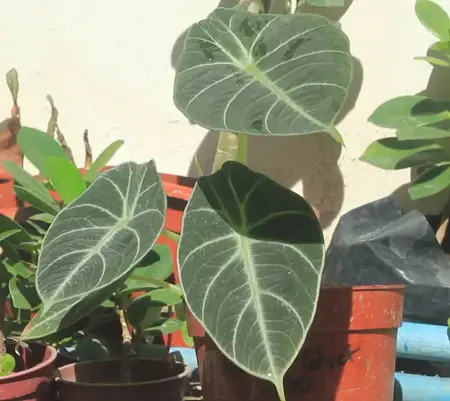
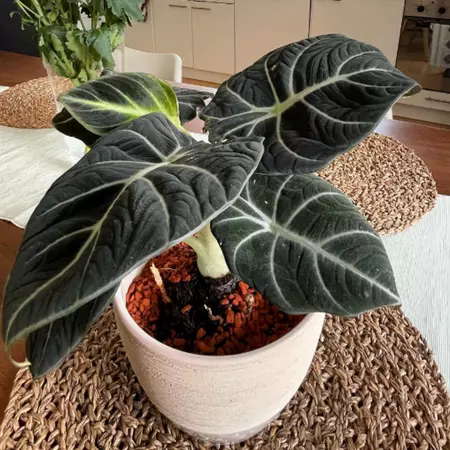
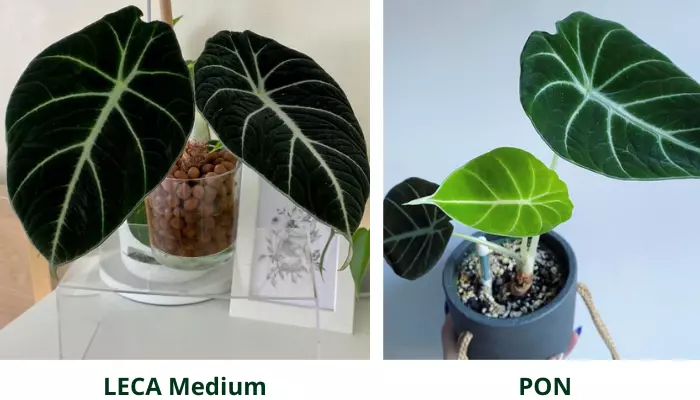
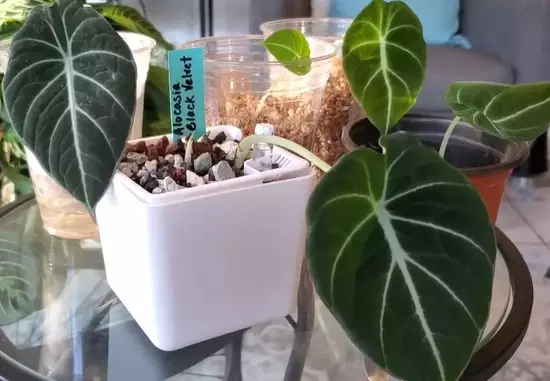

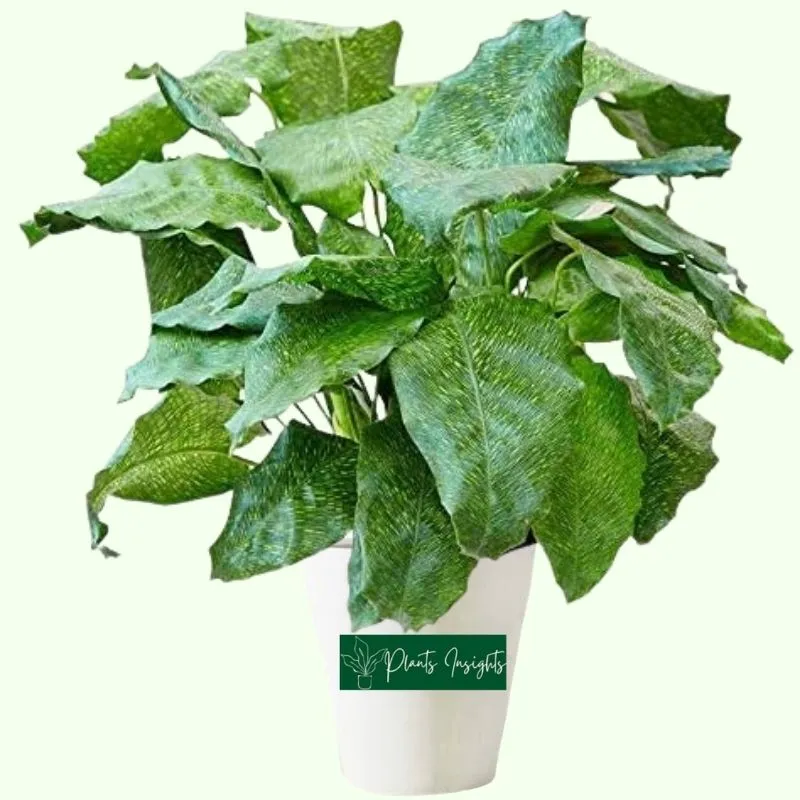
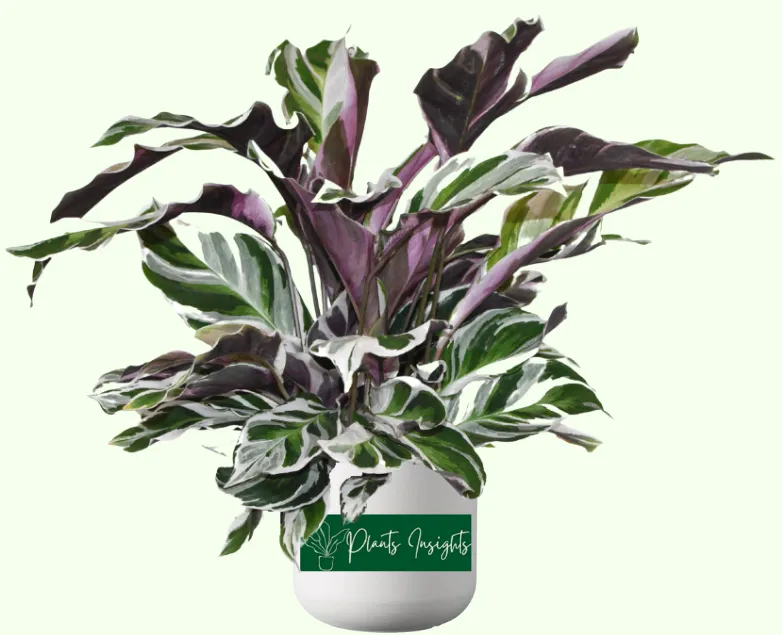
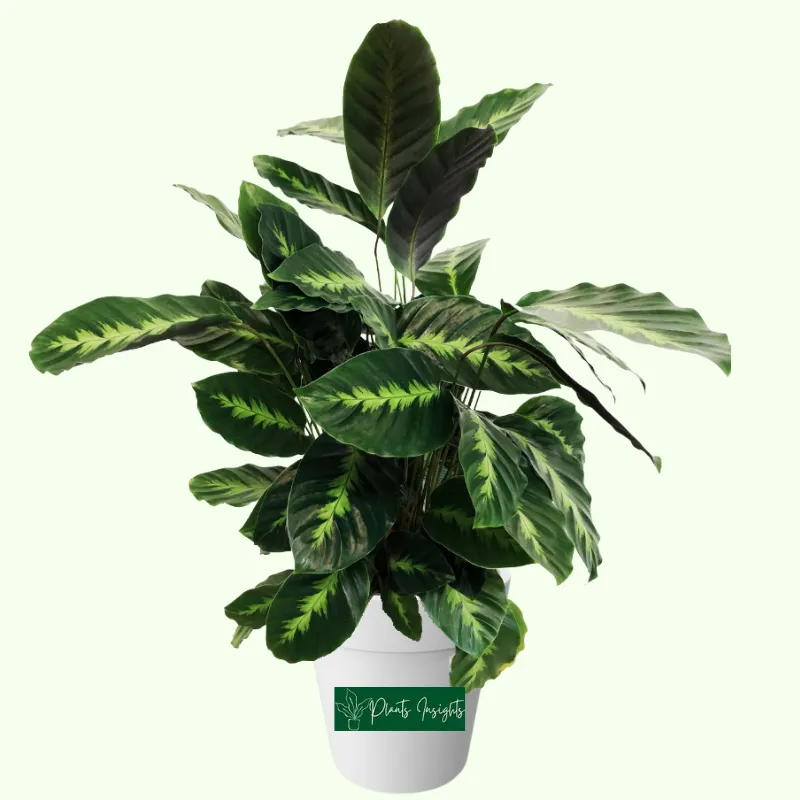
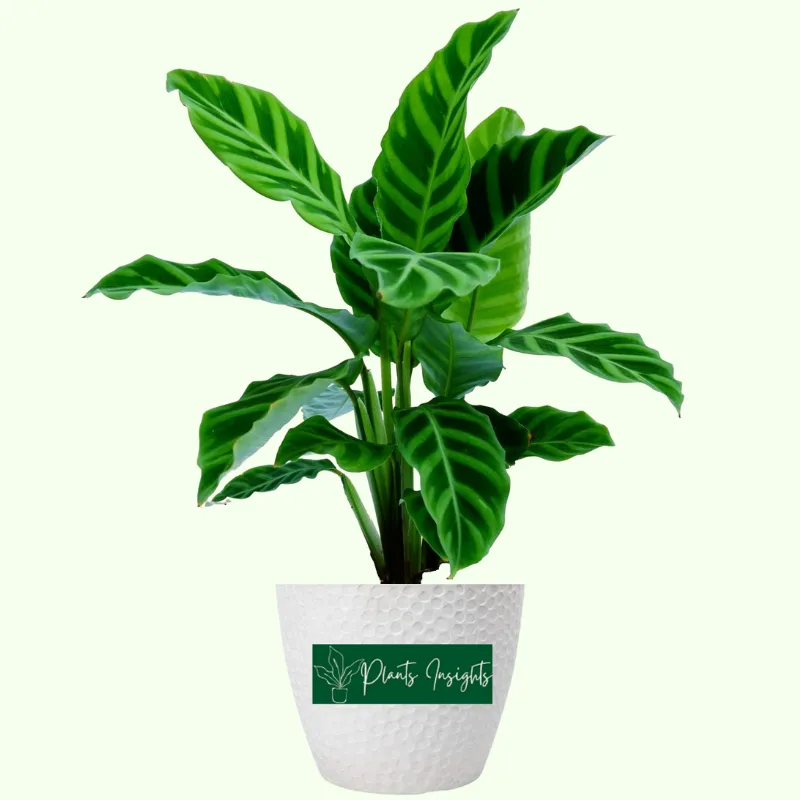

Precisely what I was searching for, appreciate it for putting up.